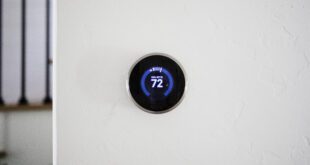Spring cleaning has numerous health benefits. Along with removing dust, dirt, and bacteria that has accumulated over the winter months, a clean interior can help improve your mental health, while offering the chance to make your home or business more energy efficient, saving you money while improving the health of the planet.
According to a recent Shelton Group Utility Pulse study, energy efficiency is on the decline within American households, despite the implications of climate change. In today’s climate change-affected world, where there is accelerated sea level rise and more frequent heat waves than seen in the past, it’s more important than ever to reduce carbon emissions as much as possible, even if that only means within your home.
A spring cleaning venture is the perfect opportunity for both home and business owners to improve energy efficiency. These improvements can be small, such as switching out traditional incandescent light bulbs for LED versions and changing air filters, or much larger, encompassing energy-efficient remodeling projects — either way, taking steps toward more efficient energy usage will be meaningful, even in the smallest of ways.
Building Maintenance and Energy Efficiency
No matter if you are cleaning your home or workplace after a long winter, you have ample opportunity to improve your building’s overall efficiency. Firstly, ensure that all of your lamps and lighting fixtures are outfitted with LED bulbs, which have a longer lifespan than traditional bulbs and require less energy to operate. Clean out all air and heating ducts, and change filters where necessary.
Next, conduct an annual service check on your air conditioning units. After months of not being used, A/C units can collect large amounts of debris that should be removed prior to operation in order to keep them running as efficiently as possible and not polluting the air. You should also inspect your unit for signs of damage, including overheated wires or coils, as even small amounts of damage can reduce your unit’s efficacy. It’s also recommended that you check freon levels and replace A/C units that are more than 15 years old.
Other maintenance tasks that can improve energy efficiency include checking windows and doors for leaks, as well as adding weather-stripping or caulk to any problem areas. The U.S. Department of Energy reports that reducing the amount of air that leaks in and out of your home can help reduce energy costs and create a healthier indoor environment. The spots where plumbing, electrical, wiring, and duct work comes through walls are additional trouble areas that should be inspected for leaks.
Staying Organized When Spring Cleaning
You may not realize it, but clutter can negatively impact a building’s energy efficiency. “When furniture, boxes, and other items block vents or windows, you may consume more energy, as your heating and cooling systems will have to work harder,” according to Green Home Guide. For that reason alone, reducing clutter is an essential part of spring cleaning.
By storing some items that are taking up space in your home or business, such as special occasion dishware and kitchen appliances that are only used sporadically, you can quickly reduce clutter. Organization is another key component of the spring cleaning process. In the kitchen, make sure to inspect all dry goods and discard any expired items. Then, organize your pantry in such a way that you can easily see items on hand, which helps to reduce food waste.
You may want to invest in storage solutions like hanging produce baskets and racks that hang over the pantry door. By utilizing these high spaces, you can easily combat clutter while increasing your storage capacity.
Energy-efficient Home Improvements
When decluttering and reducing air leaks fail to make a significant impact on your building’s energy efficiency, it may be time to consider the benefits of a larger renovation. A home improvement project can give you the opportunity to address existing energy efficiency concerns on a larger scale, especially in older homes that weren’t built with the environment in mind. For example, with a complete kitchen remodel, you can upgrade appliances to ensure that they are Energy Star rated, as well as fix air leaks.
Many households may lack the funds to undertake a home improvement project, but there are numerous options at your disposal. For some homeowners, a home improvement loan may be the perfect choice when considering energy-efficient renovations. Loans of this type often use your home’s equity as the basis for home improvement funds, and you can use the loan money to renovate any area of your home.
Energy-efficient home improvements may also include the addition of water-saving sink and shower fixtures, or even the installation of solar panels. U.S. homeowners who invest in these types of home improvements may qualify for tax credits under the federal government’s Nonbusiness Energy Property Credit, which is still available through December 2021.
On a global scale, we have seen real progress towards greater energy efficiency, but more improvement is needed, according to the World Energy Council. And worldwide energy efficiency gains start at the individual level. Whether it involves minor maintenance, clutter reduction and organization, or a large-scale home improvement project, spring cleaning can make a big difference in your energy efficiency close to home.
 Alternative Energy HQ solar power for homes, wind energy, and bio fuel issues
Alternative Energy HQ solar power for homes, wind energy, and bio fuel issues








